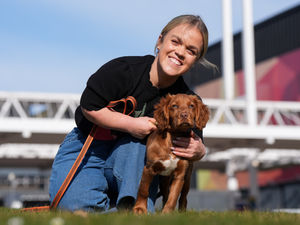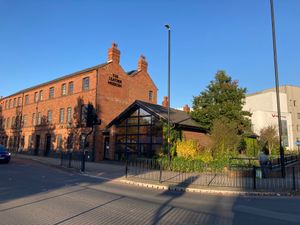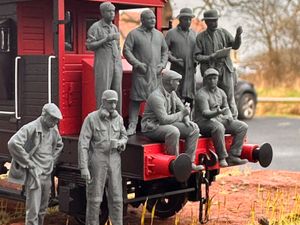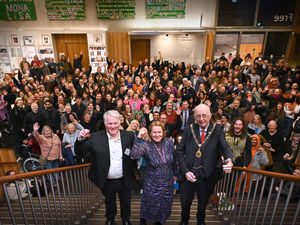80 years of animal magic at Dudley Zoo
It's where many of us first marvelled at a giraffe, watched a playful penguin dive under water or heard the impressive roar of a lion.
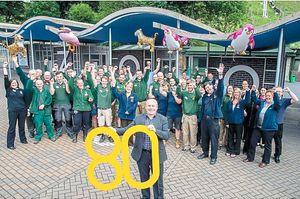
Generations have grown up visiting Dudley Zoo and now it's one of the Black Country's biggest tourist attractions welcoming hundreds of thousands of visitors through the gates every year.
When it first opened 80 years ago today, it was already at the forefront of advances in design and animal conservation.
It's Modernist buildings, constructed around an 11th century castle, aimed to protect the welfare of the animals while meeting visitors' demands for a clear view from a safe position.
This ideology continues today with the zoo staff always carefully balancing the wishes of the admission-paying public with the comfort and security of all of the creatures in their care.
The idea to convert Dudley Castle’s grounds into zoological gardens had come from its then owner, the third Earl of Dudley, and it proved an instant hit with tens of thousands of people turning out for opening day.
Now it's home to nigh on 200 species, many of which are endangered including the Asiatic lions, Sumatran tigers, Bornean orang utans, Tibetan red pandas, Rothschild giraffes, Madagascan lemurs, and Humboldt penguins, and visitor numbers are rising.
It funds conservation projects both at home and abroad, has earned international and industry recognition for its breeding programmes and it's Modernist buildings, called The Tectons, have received World Monument Status.
Many famous faces have played part in its history including comedian Sir Lenny Henry, who started out with weekly stand-up slots in the Queen Mary Ballroom and also worked as a barman in the Safari Night Club in the early 1970s.
It has even attracted royalty with Her Majesty the Queen paying a visit to open a new interpretation centre at Dudley Castle in 1994.
And for the staff who work there, taking care of the animals day and night, looking after visitors and helping to raise conservation awareness, it's a huge part of their lives.
Zoo manager Matt Lewis lives on site with his senior keeper wife Lesley and their children 18-year-old Rodbaston College student Harry and 13-year-old Eliza.
He has been working at the zoo since May 1989 and seen it go through a lot of changes since he took up what was supposed to be a temporary summer position.
"I was all set to be an apprentice with the MEB in the September but I got a summer job at the zoo and then just never left.
"Lesley started in October of the same year so we have been working together ever since and we've been married 22 years," said Matt, aged 45.
One of his fondest memories was the birth of Pingu the Humboldt penguin, who recently turned 26 and was hand-reared by him. The zoo's penguin colony, the UK’s largest parent-reared group, continues to go from strength to strength making its great success stories, says Matt.
"We had five penguins when I first started and since then we must have bred around 400 plus. We have been very successful with our Humboldt penguins and it's something we are very proud of.
"One of our secrets is having our own water supply which ensures it's cold which the penguins like because it replicates the coldness of the deep seas in South America. We now have around 90 penguins and they are still a firm favourite with visitors," explained Matt.
As well as penguins, Matt also hand reared lion cub Sam who was born in February 1997 and the cat lived at home with the family for six months.
Sam, the first Asiatic lion to be born at the zoo, was given a Japanese Akita puppy named Connie as a playmate.
"The reason we chose a Japanese Akita is that they are very cat like in their mannerisms and movements.
"The lion was well-behaved and didn't cause any damage. But the dog was a nightmare, chewing the fire place and wrecking the carpets," said Matt.
Another long-standing member of staff is curator Richard Brown, who says he can't imagine leaving. "It gets in your blood," says the 36-year-old who has been working at the zoo for 20 years after starting as a trainee keeper at the age of 16.
He had been persuaded to ask about a job at the zoo by his mother during a day trip to the attraction in 1996 after deciding that sixth form wasn't for him.
"I applied for a trainee zoo keeper position but I actually ended up not getting the job.
"Thankfully they called me back when the successful applicant turned down the role and the rest as they say is history," explained Richard, who lives in Wombourne with his wife Sharon and two children , six-year-old Archie and three-year-old Seth.
Working with the site’s ungulates and carnivores, Richard began on 93p an hour, but worked his way through the zoo ranks to secure his current curator role two years ago.
"It is the best job in the world and it's an unique job because no two days are ever the same, you can go from looking after the animals and working with the vets to being a car park attendant and doing litter picks," he said.
He has many fond memories during his time working at the zoo but says some of the best involve the arrival of baby animals.
"I always remember my first tiger cubs. I went to check on the tigers one morning to let them out and there were three little tiger faces looking up at me," added Richard.
As well as tigers, he is also a fan of Brazilian tapirs, Meena and Chico. "The first time I saw a baby tapir it was amazing. Tapirs are like big dogs and are so gentle," he said.
Another favourite was late lion Max, who died in 2008 aged 15 following a short illness.
"I worked with him for 10 years and he was definitely a lion with character.
"He used to like to roar right in your face. I used to live in Dudley and I could hear him roaring his head off even when I was at home.
"He got used to me and wouldn't roar at me but if I took anyone new to see him, he would do it to them. He had a couple people on their backsides after giving them a scare," said Richard.
The zoo will always be special to Richard because it's where he also met his wife of nine years Sharon. "We met when she was doing work experience when we were both 17 so the zoo is a very important part of my life.
"My two sons like animals so hopefully they will follow in my footsteps," said Richard.
Zoo Director Derek Grove, said: "Dudley Zoo is a great place where families build shared experiences and stories of ‘when the elephant ate nan's best gloves’ or ‘when the monkey showed his bum to dad’.
"But it is also a place that has changed. We would no longer consider housing a killer whale and dolphins in the pools within the castle moat and strict criteria are followed to ensure that we create naturalistic habitats to meet the animals welfare needs.
"Plans to transform the zoo started in the 1980’s, and we continue to expand and improve the facilities for the animals and visitors, for example where we once housed a common hippo, is now a fantastic exhibit for lar gibbons, as we extended on to a rear bank and incorporated some of the site's existing mature trees and we followed the same methodology with Lemur Wood and our gelada exhibits.
"When you visit the Dudley Zoo today, the roads and listed buildings remain the same but the zoo has changed and will continue to fund conservation projects within this country and abroad."

